
Explore up to the Cape Fur Seal colony at Pelican Point
Pelican Point is home to a great array of wildlife, including a Cape Fur Seal colony. This tour to Pelican Point is ideal for nature lovers and photographers looking for some subject material. You will see the Lighthouse and other structures erected by the settlers of Walvis Bay, and learn a little about their history. As you can see from the photos on this page, the wildlife around Pelican Point is pretty photogenic. You will definitely have some good stories to tell once you get back home. Read through the tour, and if you have any questions, please do not hesitate to contact us.
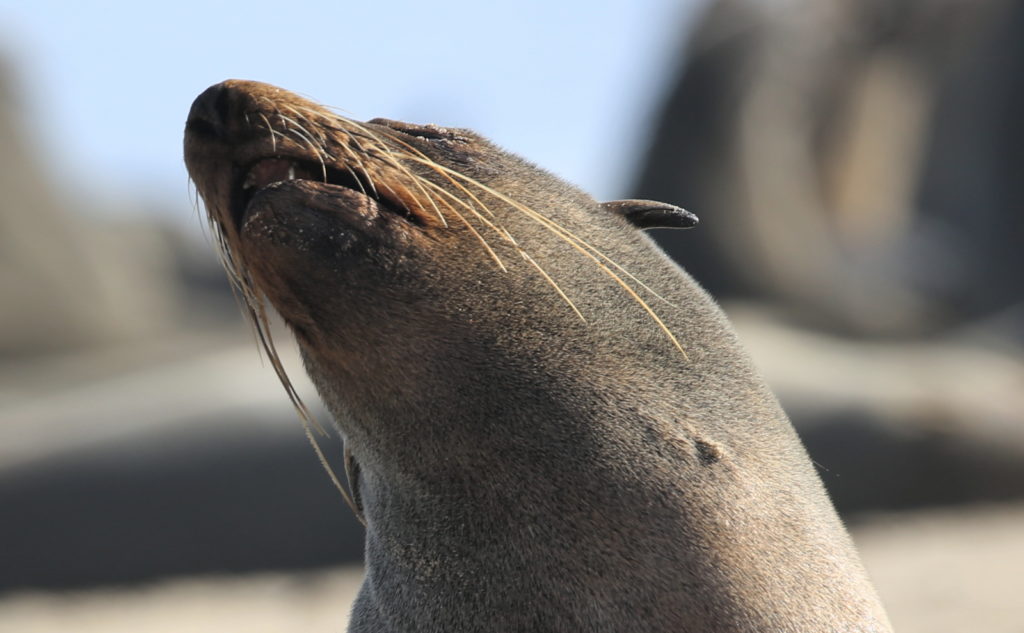
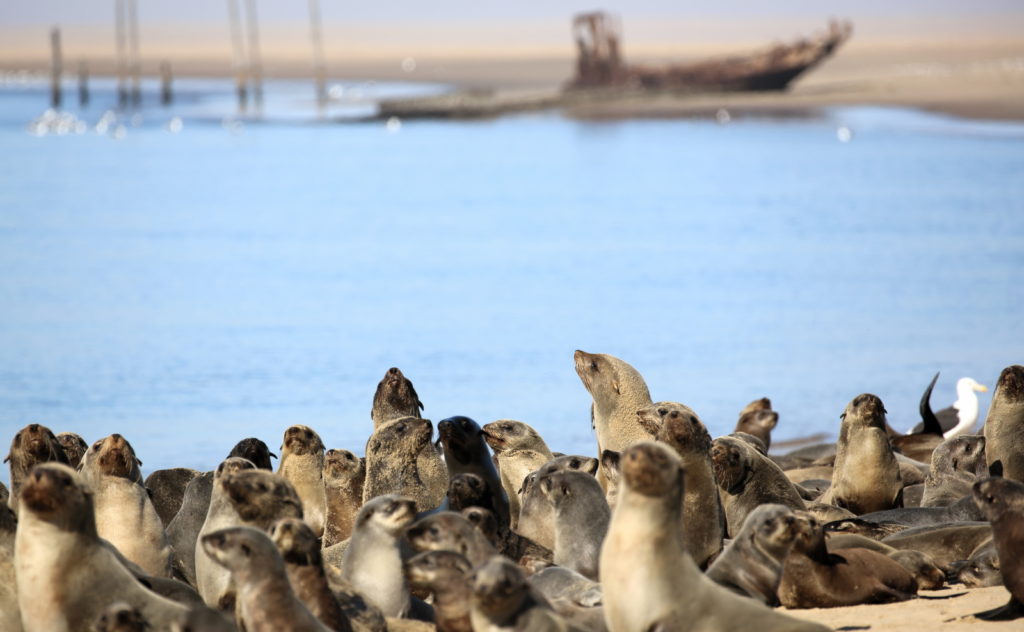
Seal colony 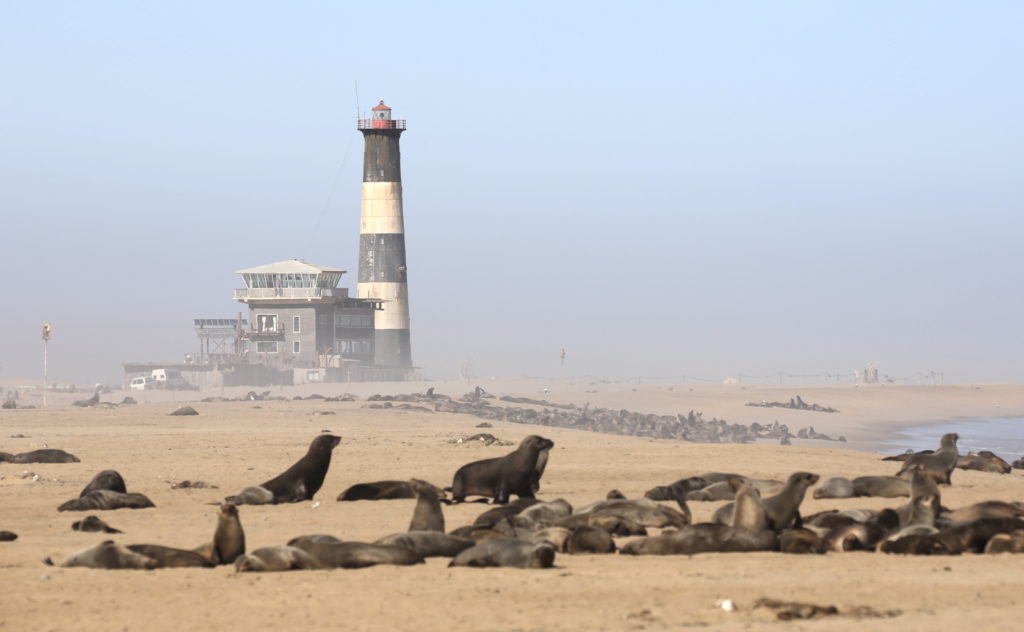
Lighthouse of Walvis Bay
You will only get the best service at Awesome Chapters. Your private tour guide will pick you up at your address anywhere in Walvis Bay with the tour vehicle, free of charge. Your pickup time is not fixed, but agreed upon during the booking process. If you are arriving on a cruise liner, you have the option to be collected from the ship inside the harbor gates. Should you wish to be picked up outside of the Walvis Bay, just cover our fuel costs with a small transfer fee.
On the tour itself, you can always have still water as a standard, and if you want any other refreshments during the tour, just mention it during the booking process. Continue reading about all the beautiful sights you will see on the tour!
Walvis Bay Wetlands
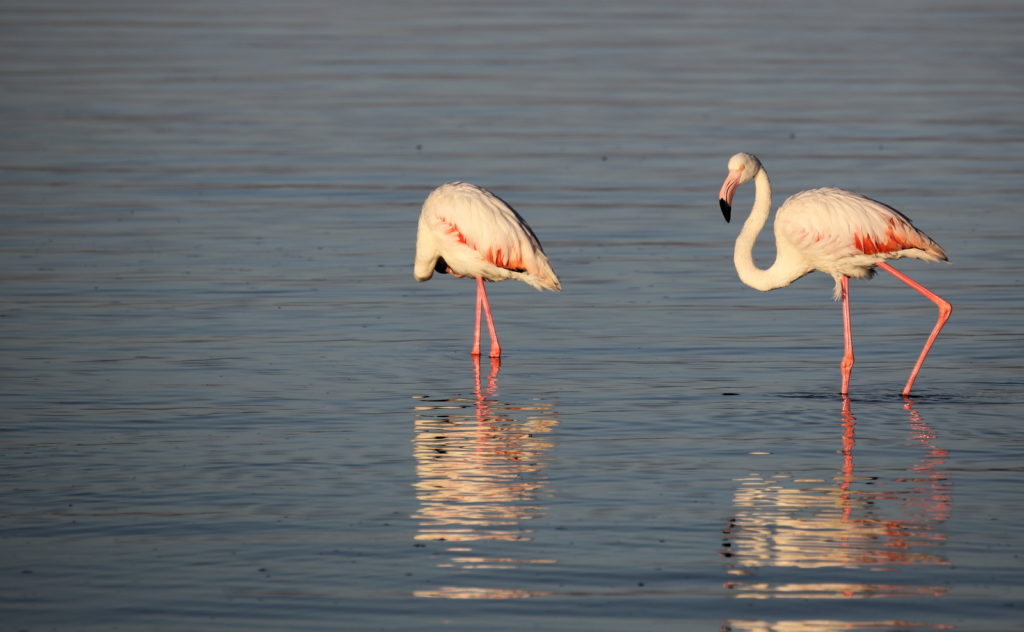
Your tour to Pelican Point starts with the Walvis Bay lagoon. The lagoon and surrounding wetlands is a RAMSAR site, and is teeming with protected wildlife. You can get really close to the Flamingo at the lagoon to take some stunning pictures. With a bit of luck, you will also see the Great White Pelican, as they are frequently spotted at the lagoon as well. The weather is usually quite nice in the mornings, leading to glassy seas and good reflections, as demonstrated with the photo above.
Situated in the wetlands is the Walvis Bay Salt Holdings processing plant. The process by which the salt is extracted leads to the sea water turning bright pink due to the high concentration of micro-organisms naturally found in the ocean. You will have a good opportunity to take some awesome shots of this phenomenon when you stand on top of the dune neighboring the processing plant. The regular shapes of the pans and pink water makes for some very striking subjects.
You will see the pink water and salt crystals up close at the salt pans, on the way to the ocean. The salt pans are also home to a respectable array of bird species, including Lesser and Greater Flamingo, Great White Pelican, Heron/Egret, Mallard Duck and many more smaller species.
The sand spit

The sand spit that forms the protective barrier of Walvis Bay harbor is changing constantly. On some days with very high tides it is covered in water, making for an adventurous journey to Pelican Point. Other times it is bone dry, and you can see the salt roads that forms naturally on the flats on the way to Pelican Point.
The shape of the coastline here is constantly changing with the ocean eating away at some places, and depositing the sand in others. At Donkey Bay, or “Skeleton Bay” as it is known in the international surfer community, the erosion was once so bad that it was once thought that the area around the lighthouse was turning into an island. The remnants of a service road to try and stop this is still visible up to where it was washed away.
When the lighthouse was constructed at Pelican Point in the early 1900’s, it was built at the tip of the sand spit. The spit is still growing even today, and every few years a radar reflector was added to warn vessels approaching in the fog where the spit had grown to. The tip of the sand spit is where the bulk of the Cape Fur Seal colony is hanging out.
Pelican Point lighthouse
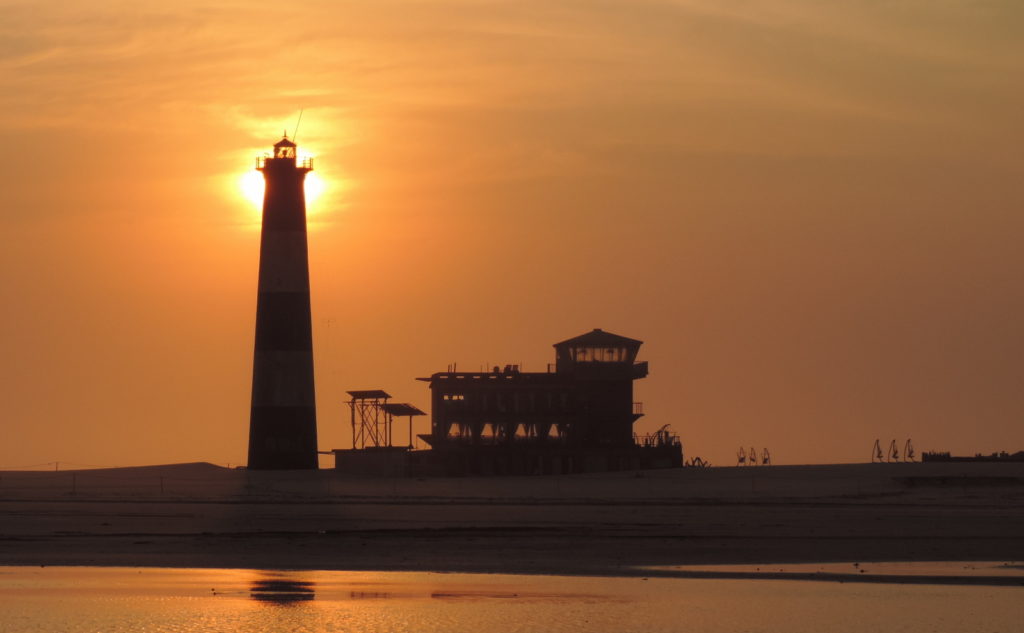
Guarding over Walvis Bay is the lighthouse at Pelican Point. Chief of which is the lighthouse, constructed in 1932. It’s construction is from cast iron, and was erected by the South African government to replace a much smaller structure. If you are interested in a more detailed history Pelican Point and of this structure, read the link here. The photo above was taken close to sunset after quite a big storm dumped a lot of water in the depression between the Lighthouse and the iron shipwreck also located at Pelican Point.
The adjoining structure is now a very nice boutique hotel, Pelican Point Lodge. Access to this hotel is restricted to guests of the hotel only. As the lighthouse is no longer an active navigational beacon, it’s light has been replaced by a much dimmer one.
The remains of a railroad track links the lighthouse with a concrete jetty on the Walvis Bay side of the sand spit. The jetty was used to land fuel at Pelican Point for refueling the generators for the lighthouse light. The fuel loaded on to a small cart that is still visible. This tram and oil drums on it was pulled by a horse to the lighthouse. Around the jetty is the edge of the Cape Fur Seal colony, and you can usually find one hiding under the jetty.
Shipwreck – Norwegian whaler
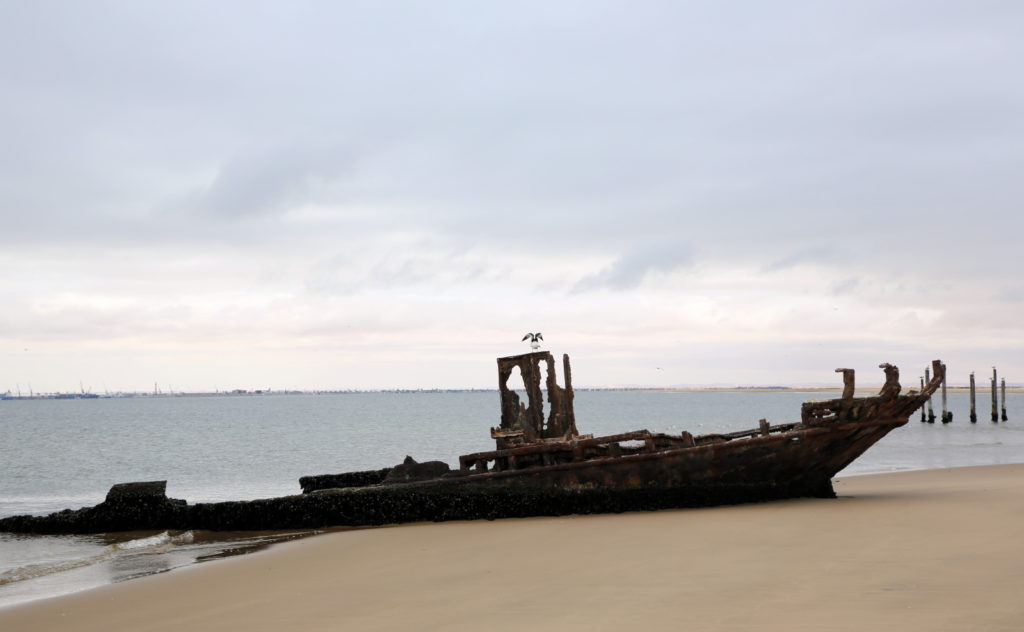
This little shipwreck near to the Lighthouse of Pelican Point lays bare a part of the history of Walvis Bay that is quite sad and disturbing. The name of the wreck is unknown, but what is known is that it was part of a Norwegian 14 killer whaler fleet employed to hunt the Wales at Walvis Bay to near extinction. It is very sad that in a town with a name that is literally “Whale Bay” it is extremely rare to have a whale sighting. You can still see whale bones dotted around Walvis Bay to this day, and there is no escaping this part of the history of Walvis Bay.
Whales were hunted by small and very maneuverable ships like this one, harpooned and brought to shore. The death of the whales were horrendous and lasted hours. Later large floating factory ships rendered Walvis Bay obsolete. If you are interested in this history, there is more about it here, here and here.
Due to the world-wide conservation efforts, whale sightings are becoming more common in this area. It is a very slow process due to the slow gestation and reproductive cycle of whales.
Wildlife – Cape Fur Seal colony
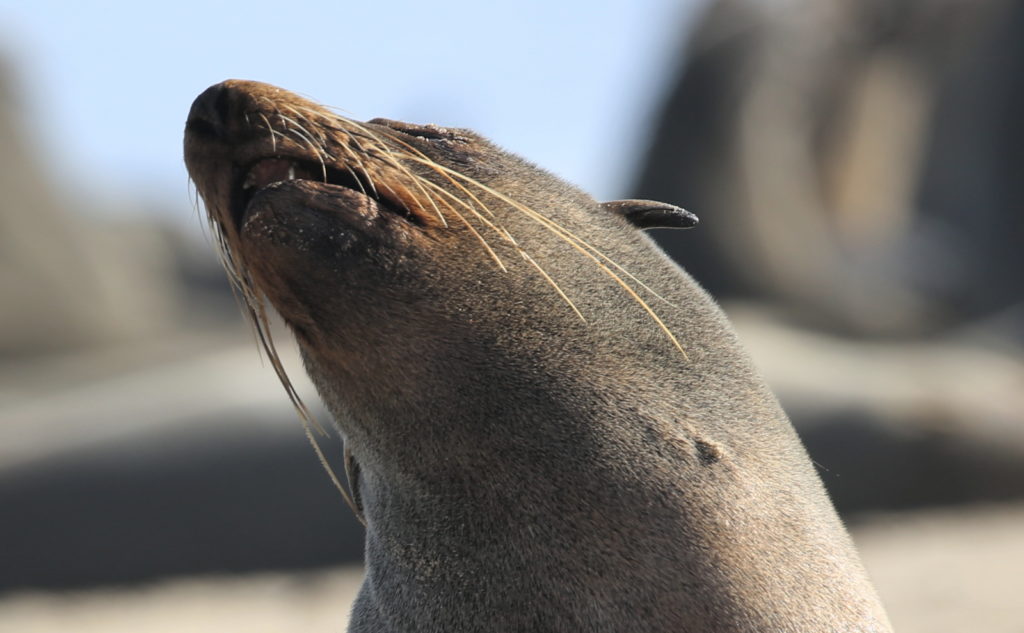
Pelican point is home to quite a bit of wildlife, most notable is the Cape Fur Seal colony. At over a hundred thousand strong, the Cape Fur seal colony is a very large colony, and growing each year. Due to the amazing virility and hunting success of the Cape Fur Seal, the numbers of this colony is out of control.
Due to the whaling efforts in the first half of 1900’s, most of the natural predators to the Cape Fur Seal has been removed, and is largely the cause of this population explosion. All along the coast of Namibia you can find more colonies of this Cape Fur Seal, the most notable is the colony at Cape Cross.
Your guide will tell you a little more about the Cape Fur Seal on the tour, as well as other species of wildlife that is also common here. Feeding on the Cape Fur Seal pups are Black Backed Jackal. With a bit of luck we will also see a specimen or two of them. These are also to be found, but normally in packs no larger than four. The bulk of the remainder of wildlife is avian, mostly Flamingo, and very seldom Pelican. Black backed Cape Cormorant are quite common towards Donkey Bay.
Details
- Duration: 3 hours
- Activity level: Easy/Light
Inclusions
- Bottled water
- Free pickup in Walvis Bay area
- Private, air conditioned transport
- Local guide
Optional Extras
- Pick up & Drop off in Swakopmund
- Pick up & Drop off in the port of Walvis Bay
- Food for the tour
- Special & alcoholic drinks for the tour
Payment
To keep things risk free on your side, we accept all mayor currencies on the day of the tour. For your convenience we accept VISA and Mastercard as well. Not everyone likes running around with wads of cash, of course.
Booking – Email
If you are interested in this tour, but you would like to have a discussion with us first, you are welcome to contact us for some human interaction. The booking will be made for you with the information from our chat. We love hearing from you, so even if you do not want to book the tour, and just want some more information, you are still welcome to drop us an email.
Alternatively, drop us a line on the contact form below and we will come back to you!